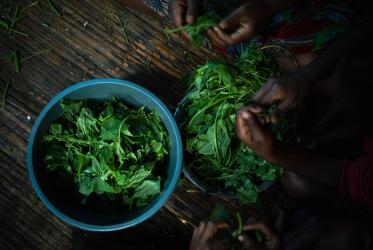The recent and ongoing flood of migrants and refugees in transit to Europe is testing not only Europe’s physical borders but its legal, security and diplomatic boundaries as well.
The overwhelming numbers have posed logistical problems for EU frontline states, swamped the creaky European asylum apparatus, created bottlenecks and spawned detention centres, and strained the political will of receiving countries, according to expert participants in the recent conference on the refugee crisis in Europe, sponsored by the World Council of Churches (WCC) and three UN agencies.
Europe’s fluid border
Stresses in the systems for welcoming and settling refugees are particularly evident in two frontline countries of transit, Greece and Italy.
The roughly one million persons who crossed by sea or land to enter Europe in 2015 included many from Syria and Iraq but also included hundreds of thousands of persons fleeing chaos in other nations south of Europe.
Greece, historically a crossroads of migration, “will continue to do its utmost, ”said Greece’s ambassador to the UN in Geneva Alexandros Alexandris. But “Greece has struggled to remain faithful to the fulfilment of the humanitarian priority of saving lives while facing multiple economic and social challenges.”
Italy, too, feels the strain, said Paulo Naso, who coordinates the study commission of the Federation of Protestant Churches in Italy (FCEI). The roughly 100,000 people rescued from the sea since October 2013, when 368 people lost their lives off the tiny island of Lampedusa, pose massive challenges for those providing them with food, shelter, protection, education, language services and registration.
But rescuing and resettling refugees is not solely an Italian problem. “Lampedusa is not the Italian border,” said Naso, pleading for more aid. “It is the European border, a place where our common culture of Europe will survive or will die.”
Systemic stresses
Registering refugees is difficult in itself. Refugees fleeing war, persecution or natural disaster are entitled to asylum in the European Union (EU) under international law. Migrants not deemed genuine refugees could be turned away.
Although international agreement among EU states and some other European nations allows free travel and passage within Europe’s so-called Schengen area — “one of the greatest achievements of the EU,” according to the Greek ambassador — asylum seekers are not entitled to free passage because of the “Dublin Regulation.”
Complaints about the EU’s Dublin Regulation were common at the conference, since it requires that asylum applications be handled by the state that receives the applicant, who must remain in that country until his or her application for asylum is processed.
Refugees resist registration and fingerprinting, as required by the Dublin system, since doing so might impede their going to their desired destination, commonly Germany or Sweden or wherever they might already have family members. Asylum requests can take up to two years to process.
“Two years!” exclaimed Naso. “After spending two years in North Africa, after risking their lives crossing the Mediterranean, you ask these people to stay two years without knowing if you will be recognized as a refugee, if you will be allowed to stay in Italy or if you will be relocated in another country. Of course, this doesn’t work!”
A special conundrum has developed over unaccompanied minors — children — those migrants (10 to 15 percent of the total) younger than 18 with no guardian present, who do not qualify for asylum yet cannot be expelled either. Already traumatized in their country of origin, they remain in a legal limbo and face years in refugee camps or temporary housing.
Often, too, families are dispersed during their sojourn or not easily connected to family members already in Europe. Women and girls require protection from gender violence and provision for sexual and reproductive health services.
Transit countries are unlikely to see immediate relief. “We’re going to continue to see massive migration,” said Dr Manuel Carballo of the International Centre for Migration, Health and Development, “not only of refugees but also of course of people who are forced to flee because of poverty and chronic poor health.”
Buoys of hope
Despite the monumental challenges, conferees offered important ideas for fixing the system or coordinating activities. The Community of Sant’Egidio, for example, represented by Msgr Marco Gnavi, detailed a new joint venture with Catholic and Protestant churches and the Italian government to open small centres where 7000 trained “mediators” can work directly with the most vulnerable refugees to integrate them into Italian culture and society.
“We need fresh forces,” said Gnavi of Italy’s aging demographic, “to hand over the baton of our heritage” to these new Italians.
Direct engagement by church communities and organizations makes sense on several levels, said Ambassador Alexandris. “In the testing times we are living in, religious and cultural leaders play a crucial and responsible role in setting the moral high ground, calling for unity, tolerance and solidarity [in] society.”
The ultimate boundary is spiritual. Migration may yet provide “a soul-searching stimulus” for Europe, he said, and perhaps impel a new age of interreligious and intercultural pluralism.
WCC/UN conference calls for coordinated action on refugee crisis
Tarek Mitri: refugee crisis highlights failures of international community
Coptic bishop from Middle East diaspora reflects on how churches can help refugees
Thomas de Maizière: On the frontlines of refugee integration





